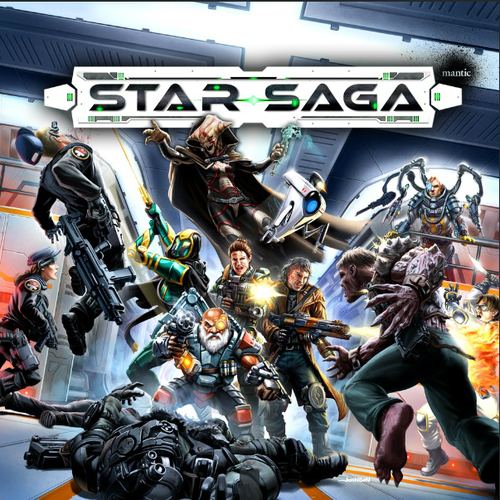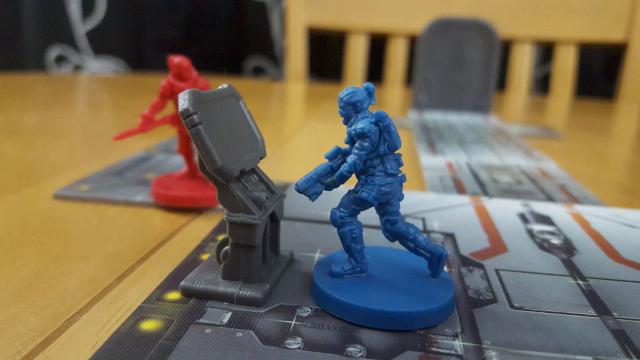
Being a bit inexperienced with the dungeon crawling scene I wasn’t too sure what to expect from Star Saga. Sure, it had some nice minis that made me wish I was good at painting them for the first time since playing Arcadia Quest, but there wasn’t really much to base initial thoughts on. The board was modular, made up of smaller parts, but that’s been fine in other games (most notably Mansions of Madness) and there was a separate book of rules alongside the mission book, but it wasn’t until I followed the tutorial, the wonderfully crafted turn by turn hand-holding session that outlines the most important rules via a simple mission that I realised that this was going to be a far easier game to learn than I imagined.
I mention all that because it’s easy to form a first impression as soon as you open the box. Some games wow you with the sheer number of miniatures, others go for impressive quality components that leap out at your as soon as you open the box up, but that’s not a feeling I had with Star Saga. It’s all nice enough, but it’s not got the wow factor, which is a shame because once you start playing, things take a huge turn for the better.
The objectives in the various missions vary, and the main series of levels act out as a story with various bits of dialog to read as you progress through the various missions. You’ll have a team of Mercenaries pitched against a single Nexus player, whose sole job is to control the bad guy minions on the board (no, not those minions) and put a stop to the action by getting rid of the Mercenaries before they can complete all the required objectives. There are some awesome bosses to drop in on the action from time to time, and while early missions will give some advantages to the Mercenaries (such as better attack stats, or outnumbering the Nexus player’s resources) as you progress on the levels become more challenging to navigate with multiple routes and less hiding places, and the bad guys become more powerful and more of a match for your good guys.
One thing I really liked about this, and I can almost guarantee hardcore dungeon crawler fans will hate, was how simple the combat was. Using a handy guide to determine weapon range and line-of-sight the player and minion cards tell you how many dice to roll. If the attacks outweigh the defensive rolls then the character either takes damage or gets taken out completely. Being in cover will allow an extra dice roll to mimic additional defensive capability, so if you’re hiding round a corner and can only just be seen, or stood behind a crate or whatever else, you’ll be slightly more likely to survive the attack. For now.

Speaking of crates, they can be searched for loot. Ace. You need to be careful not to get shot in the back while you’re doing it though, as searching for loot will use up your turn, but can dig up some really handy stuff if you’re lucky.
And in terms of the basic mechanics there isn’t much to it. The focus is very much on what to do when, without leaving yourself wide open for a beating if things don’t go well. If you’ve ever played an XCOM game you’ll know the feeling here – do you risk an attack hoping to take out an enemy (but knowing you might leave yourself wide open for a clear shot) or focus on moving into cover and take a pot-shot at the enemy from a less ideal position for attack? Or do you make a dash for the objective, trying to hack into the console, or open the door, or whatever else you need to be doing at that point… it probably depends on what your teammates are doing. Played as a group this game is really great fun. You can split into fireteams, all go it alone and hope someone makes it, or stick together and possibly trip over each other and get in the way. You can even, if you choose, play entirely alone. The rules outline a method for playing this with an AI Nexus player, and while I didn’t try it out myself it’s good to know the developer has considered that possibility.
It’s also at its best when you’re carrying out a few missions back to back, letting your characters grow as the story builds up over time. This worked well with us – none of the players we played with were overly familiar with this kind of game, and as such everyone enjoyed the simple mechanics mixed with the pretty sizeable challenge of the various missions. The Nexus player got to feel like a badass, much like the Doom board game from this time last year, and I was surprised at how well balanced the two sides were. We’ll most definitely be digging this out again when we’re after an objective driven game, and it certainly won’t take long to remind ourselves of the rules.
So for people new to games like this, whereby you set up the board as per the mission explanation, pit two teams of characters against each other and try to complete objectives while not getting blown away, Star Saga sits very nicely on a line between easy to learn and difficult to master. Dungeon crawling experts probably won’t like the fact it’s a bit simpler in terms of rules, and if that’s where you sit then I’d give it a miss, but for something a little lighter it’s definitely worth considering.

Leave a Reply